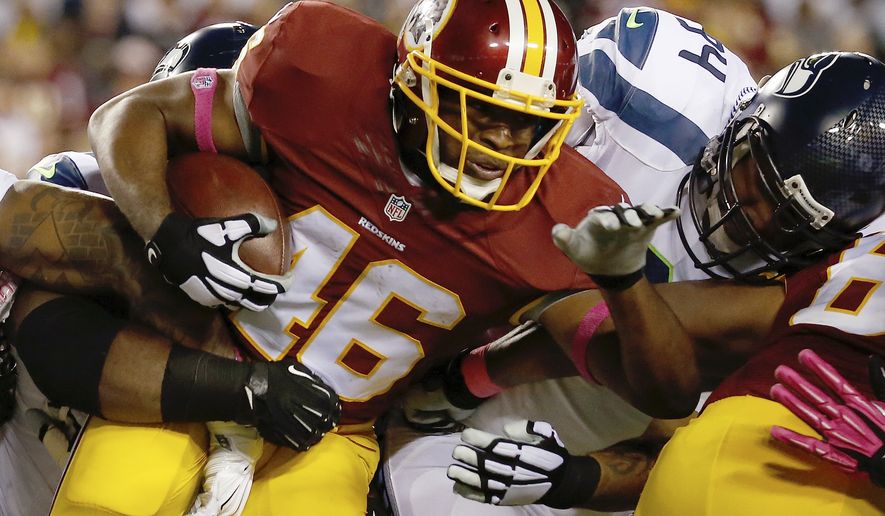When Redskins coach Jay Gruden was asked about his running game Monday afternoon, he rubbed his forehead and let out a groan.
“Where do you want to start?” Gruden said.
The Redskins led the NFL in rushing in 2012 and ranked fifth last year, even in the midst of a 3-13 season. They have finished second and third in yards per carry since the arrival of running back Alfred Morris, who entered this season with more rushing yards in the past two years than anyone besides Adrian Peterson.
Through the first seven games of this season, however, Washington’s rushing attack has been a shade of its former self. Entering Monday night’s game in Dallas, the Redskins rank 21st in rushing yards per game and 20th in yards per carry. Morris has 187 rushing yards in his past four games combined, the worst such stretch of his career. He has 440 rushing yards this season. Cowboys running back DeMarco Murray, the league leader, has 913.
The statistics pose a simple and obvious question: What happened to the Redskins’ running game? The answer is far more nuanced, and it changes from week to week.
“With the running game, it’s everybody. It’s 11 people working together,” tight end Logan Paulsen said. “So if one person’s off or one person’s not seeing something the right way or we miscall something, it leads to a not-successful play. That’s one of the great things and one of the challenges about the running game: you have to get everybody clicking, seeing it the same way.”
SEE ALSO: For Colt McCoy, staying ready for his opportunity pays off
Those searching for a singular answer — a player, coach or position group to blame — will come up empty-handed. On some plays, it’s an ineffective or missed block by an offensive lineman, tight end or wide receiver. On others, it’s a missed cut or poor vision by Morris. “It’s a combination of everything,” Gruden said.
There are, however, recurring themes. And Morris said it all starts with him.
While watching film of Sunday’s win over the Tennessee Titans, a game in which he had only 54 rushing yards on 18 carries, Morris said he noticed minor differences in what he calls his “track,” the path he takes while carrying the ball. He said his track is too tight, too close to the line of scrimmage, limiting potential cutback opportunities and preventing linemen from effectively setting up their blocks.
“I can’t really read it out like I’m supposed to,” Morris explained. “You think it’s nothing, like, ’Oh, it’s just a tight track.’ But when you really look at it, especially after watching last week’s film, it was like, ’Man. Geez. If my track was just a little wider, I could’ve pressed that more and set that block up a little better so I can get downhill.’ It’s little things like that. They make a huge difference.”
It’s easy to point to the Redskins’ offensive line as the source of the team’s rushing woes, but Morris said that is not the case.
“Overall, I feel like I’m not setting up their blocks,” he said. “In this type of offense, you have to be able to set up the O-linemen’s blocks. Like I said, when my track is too tight and I’m not pressing it, guys are just crossing their face. It really comes back to the ballcarrier.”
That’s not to say the blocking has been perfect, however. Gruden said there were instances last week in which the team’s guards did not get to the second level of the defense, or the back side of a running play was not sealed properly.
Paulsen said it’s not as much about blown assignments as it is a combination of blocks that are not executed perfectly.
“Let’s say for example I’m working on a double team and I don’t shave it enough for the tackle,” he said. “The tackle’s going to look really bad, but that’s really my fault, you know? Even though I ended up blocking my right guy and stuff like that, I could’ve helped him out more.”
As they continue to address their sputtering ground game, the Redskins are not singling out individual players or individual mistakes. There is no finger-pointing occurring in the film room. Some players are not especially eager to dwell on the team’s woes, either.
“We probably don’t need the media’s help in addressing it. I know that,” center Kory Lichtensteiger said. “We’ll probably address it within our room and continue to work through it.”
Though a combination of factors are at work, Morris did not shy away from individual criticism. In 2012, he had 658 yards through the first seven games of the season. In 2013, he had 565. This year, his 440 yards translate to a career-worst 3.8 yards per carry.
“We’ve just got to keep giving it to him and keep giving him the looks,” Gruden said. “But as far as him digressing from last year, I don’t think he is. I still think he’s the same guy.”
Morris feels that way, too. But that doesn’t mean he’s not doing everything he can to improve.
“I’m definitely going to try to do a better job of correcting those small things. I think in the big picture, it’ll translate out there on the field into a better running game,” Morris said. “Like I said, those little things can make a huge difference.”
• Tom Schad can be reached at tschad@washingtontimes.com.




Please read our comment policy before commenting.